EX1.6 Operations, Quality, and Supply Chain Management Analysis
VerifiedAdded on 2022/09/27
|15
|4726
|28
Report
AI Summary
This report provides a comprehensive analysis of operations, quality, and supply chain management within various industries. It critically evaluates business operations in companies like Toyota, McDonald's, and Marriott International, examining how operations management supports business objectives. The report delves into the application of lean techniques, process improvements, and the crucial role of customer service in each organization. It also scrutinizes different quality models, such as TQM and Six Sigma, assessing their advantages and disadvantages. Furthermore, the report explores supply chain theories, the importance of logistics, and the requirements for effective contract management. The report highlights the financial and goodwill impacts of customer service, emphasizing the importance of satisfying customer needs through value-added services. By examining these elements, the report provides a detailed overview of how these elements contribute to business success.
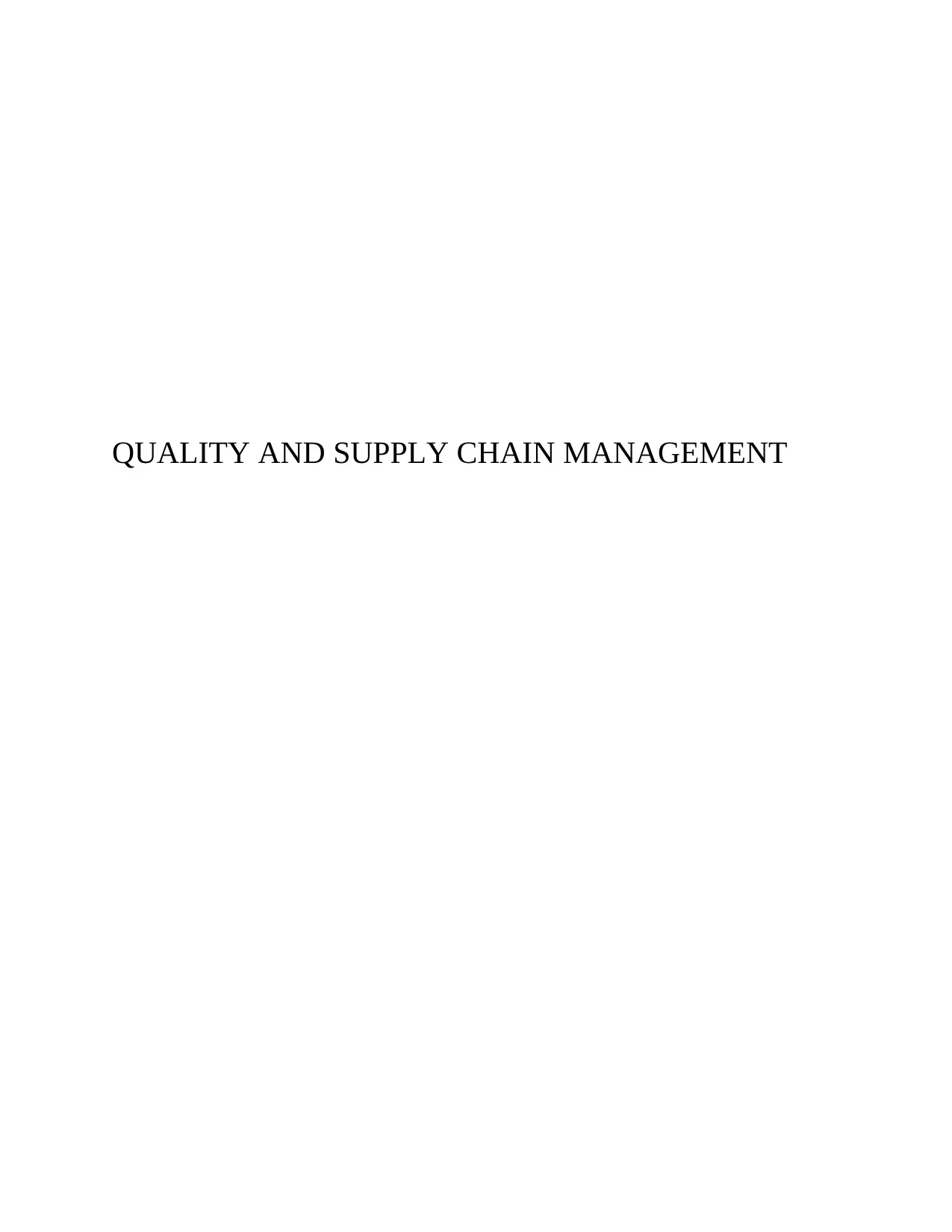
QUALITY AND SUPPLY CHAIN MANAGEMENT
Paraphrase This Document
Need a fresh take? Get an instant paraphrase of this document with our AI Paraphraser
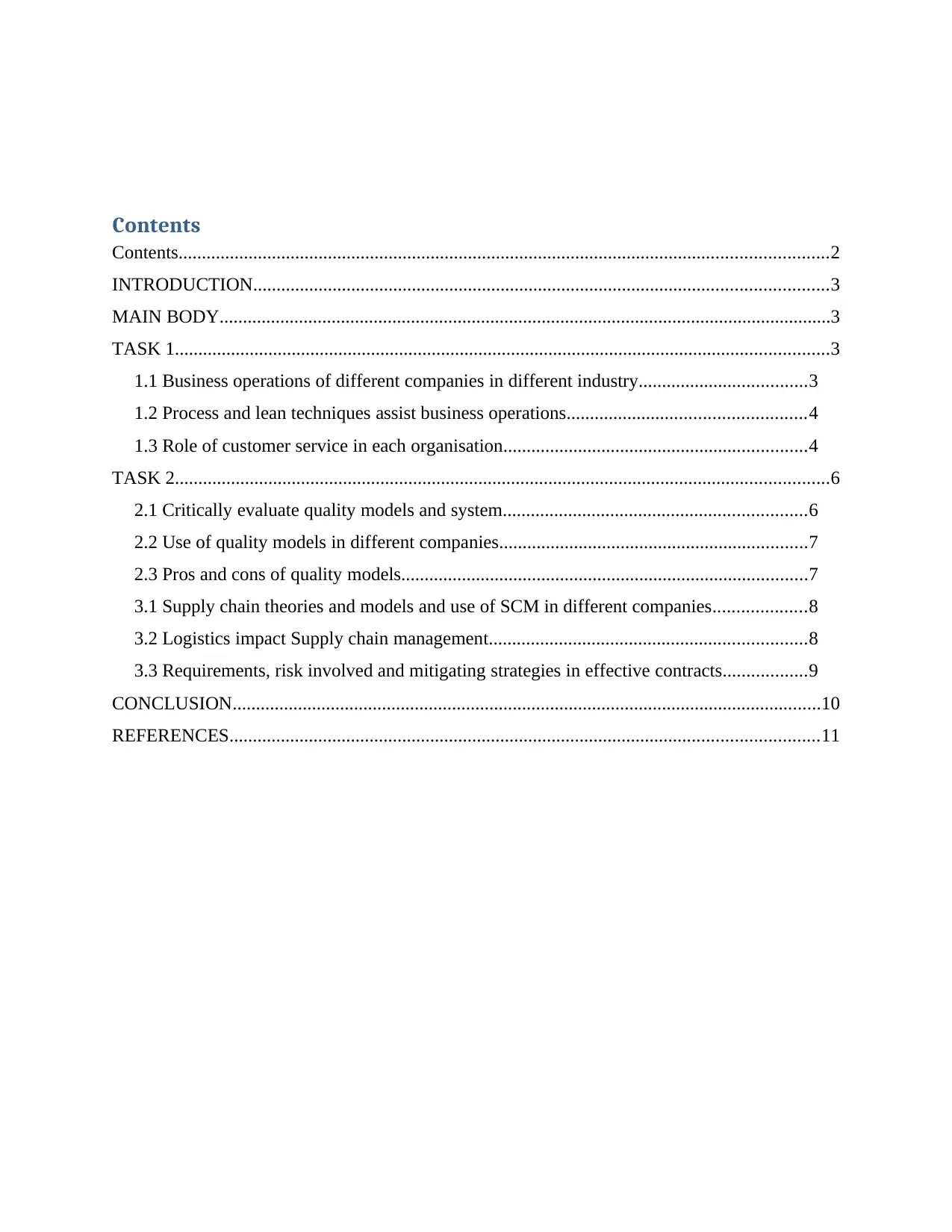
Contents
Contents...........................................................................................................................................2
INTRODUCTION...........................................................................................................................3
MAIN BODY...................................................................................................................................3
TASK 1............................................................................................................................................3
1.1 Business operations of different companies in different industry....................................3
1.2 Process and lean techniques assist business operations...................................................4
1.3 Role of customer service in each organisation.................................................................4
TASK 2............................................................................................................................................6
2.1 Critically evaluate quality models and system.................................................................6
2.2 Use of quality models in different companies..................................................................7
2.3 Pros and cons of quality models.......................................................................................7
3.1 Supply chain theories and models and use of SCM in different companies....................8
3.2 Logistics impact Supply chain management....................................................................8
3.3 Requirements, risk involved and mitigating strategies in effective contracts..................9
CONCLUSION..............................................................................................................................10
REFERENCES..............................................................................................................................11
Contents...........................................................................................................................................2
INTRODUCTION...........................................................................................................................3
MAIN BODY...................................................................................................................................3
TASK 1............................................................................................................................................3
1.1 Business operations of different companies in different industry....................................3
1.2 Process and lean techniques assist business operations...................................................4
1.3 Role of customer service in each organisation.................................................................4
TASK 2............................................................................................................................................6
2.1 Critically evaluate quality models and system.................................................................6
2.2 Use of quality models in different companies..................................................................7
2.3 Pros and cons of quality models.......................................................................................7
3.1 Supply chain theories and models and use of SCM in different companies....................8
3.2 Logistics impact Supply chain management....................................................................8
3.3 Requirements, risk involved and mitigating strategies in effective contracts..................9
CONCLUSION..............................................................................................................................10
REFERENCES..............................................................................................................................11
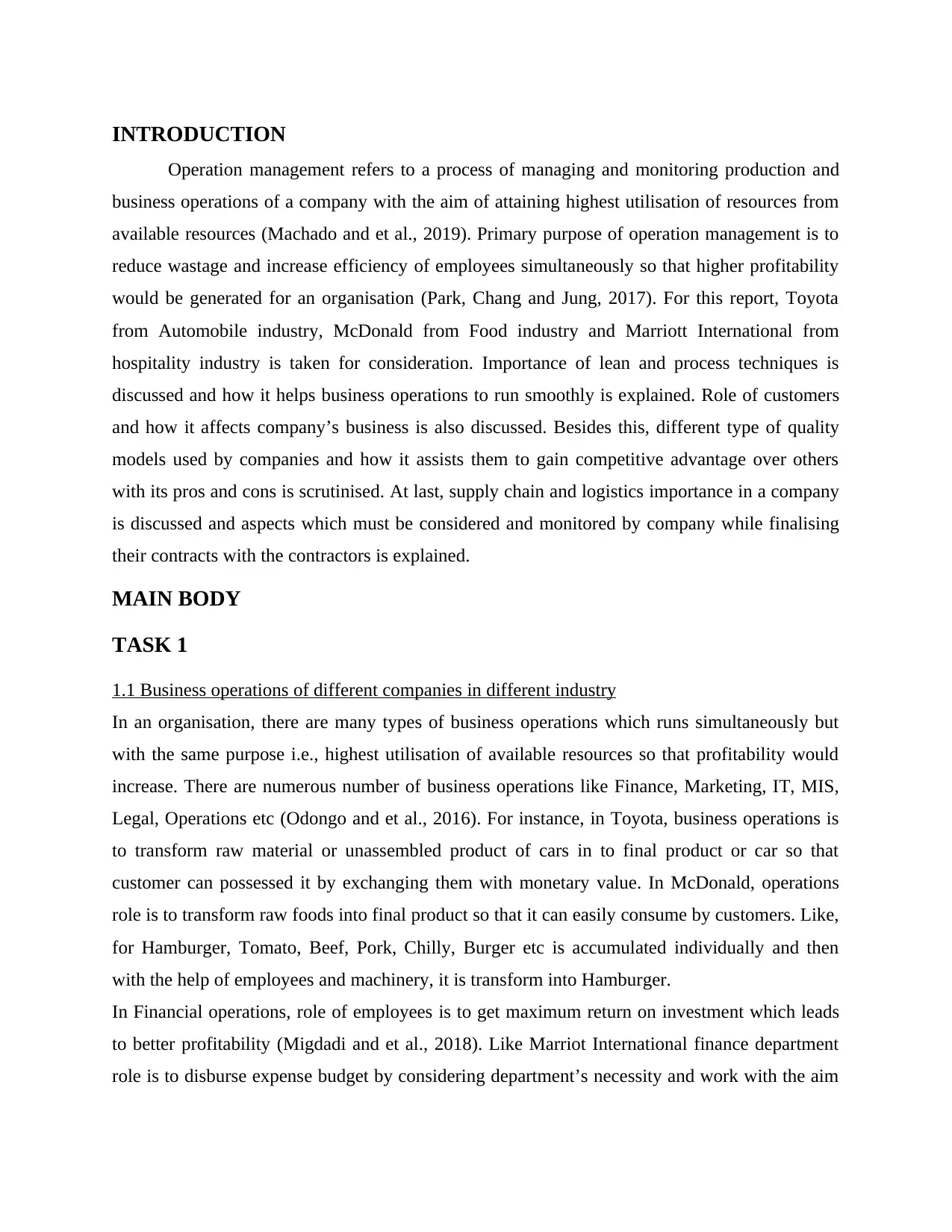
INTRODUCTION
Operation management refers to a process of managing and monitoring production and
business operations of a company with the aim of attaining highest utilisation of resources from
available resources (Machado and et al., 2019). Primary purpose of operation management is to
reduce wastage and increase efficiency of employees simultaneously so that higher profitability
would be generated for an organisation (Park, Chang and Jung, 2017). For this report, Toyota
from Automobile industry, McDonald from Food industry and Marriott International from
hospitality industry is taken for consideration. Importance of lean and process techniques is
discussed and how it helps business operations to run smoothly is explained. Role of customers
and how it affects company’s business is also discussed. Besides this, different type of quality
models used by companies and how it assists them to gain competitive advantage over others
with its pros and cons is scrutinised. At last, supply chain and logistics importance in a company
is discussed and aspects which must be considered and monitored by company while finalising
their contracts with the contractors is explained.
MAIN BODY
TASK 1
1.1 Business operations of different companies in different industry
In an organisation, there are many types of business operations which runs simultaneously but
with the same purpose i.e., highest utilisation of available resources so that profitability would
increase. There are numerous number of business operations like Finance, Marketing, IT, MIS,
Legal, Operations etc (Odongo and et al., 2016). For instance, in Toyota, business operations is
to transform raw material or unassembled product of cars in to final product or car so that
customer can possessed it by exchanging them with monetary value. In McDonald, operations
role is to transform raw foods into final product so that it can easily consume by customers. Like,
for Hamburger, Tomato, Beef, Pork, Chilly, Burger etc is accumulated individually and then
with the help of employees and machinery, it is transform into Hamburger.
In Financial operations, role of employees is to get maximum return on investment which leads
to better profitability (Migdadi and et al., 2018). Like Marriot International finance department
role is to disburse expense budget by considering department’s necessity and work with the aim
Operation management refers to a process of managing and monitoring production and
business operations of a company with the aim of attaining highest utilisation of resources from
available resources (Machado and et al., 2019). Primary purpose of operation management is to
reduce wastage and increase efficiency of employees simultaneously so that higher profitability
would be generated for an organisation (Park, Chang and Jung, 2017). For this report, Toyota
from Automobile industry, McDonald from Food industry and Marriott International from
hospitality industry is taken for consideration. Importance of lean and process techniques is
discussed and how it helps business operations to run smoothly is explained. Role of customers
and how it affects company’s business is also discussed. Besides this, different type of quality
models used by companies and how it assists them to gain competitive advantage over others
with its pros and cons is scrutinised. At last, supply chain and logistics importance in a company
is discussed and aspects which must be considered and monitored by company while finalising
their contracts with the contractors is explained.
MAIN BODY
TASK 1
1.1 Business operations of different companies in different industry
In an organisation, there are many types of business operations which runs simultaneously but
with the same purpose i.e., highest utilisation of available resources so that profitability would
increase. There are numerous number of business operations like Finance, Marketing, IT, MIS,
Legal, Operations etc (Odongo and et al., 2016). For instance, in Toyota, business operations is
to transform raw material or unassembled product of cars in to final product or car so that
customer can possessed it by exchanging them with monetary value. In McDonald, operations
role is to transform raw foods into final product so that it can easily consume by customers. Like,
for Hamburger, Tomato, Beef, Pork, Chilly, Burger etc is accumulated individually and then
with the help of employees and machinery, it is transform into Hamburger.
In Financial operations, role of employees is to get maximum return on investment which leads
to better profitability (Migdadi and et al., 2018). Like Marriot International finance department
role is to disburse expense budget by considering department’s necessity and work with the aim
⊘ This is a preview!⊘
Do you want full access?
Subscribe today to unlock all pages.

Trusted by 1+ million students worldwide
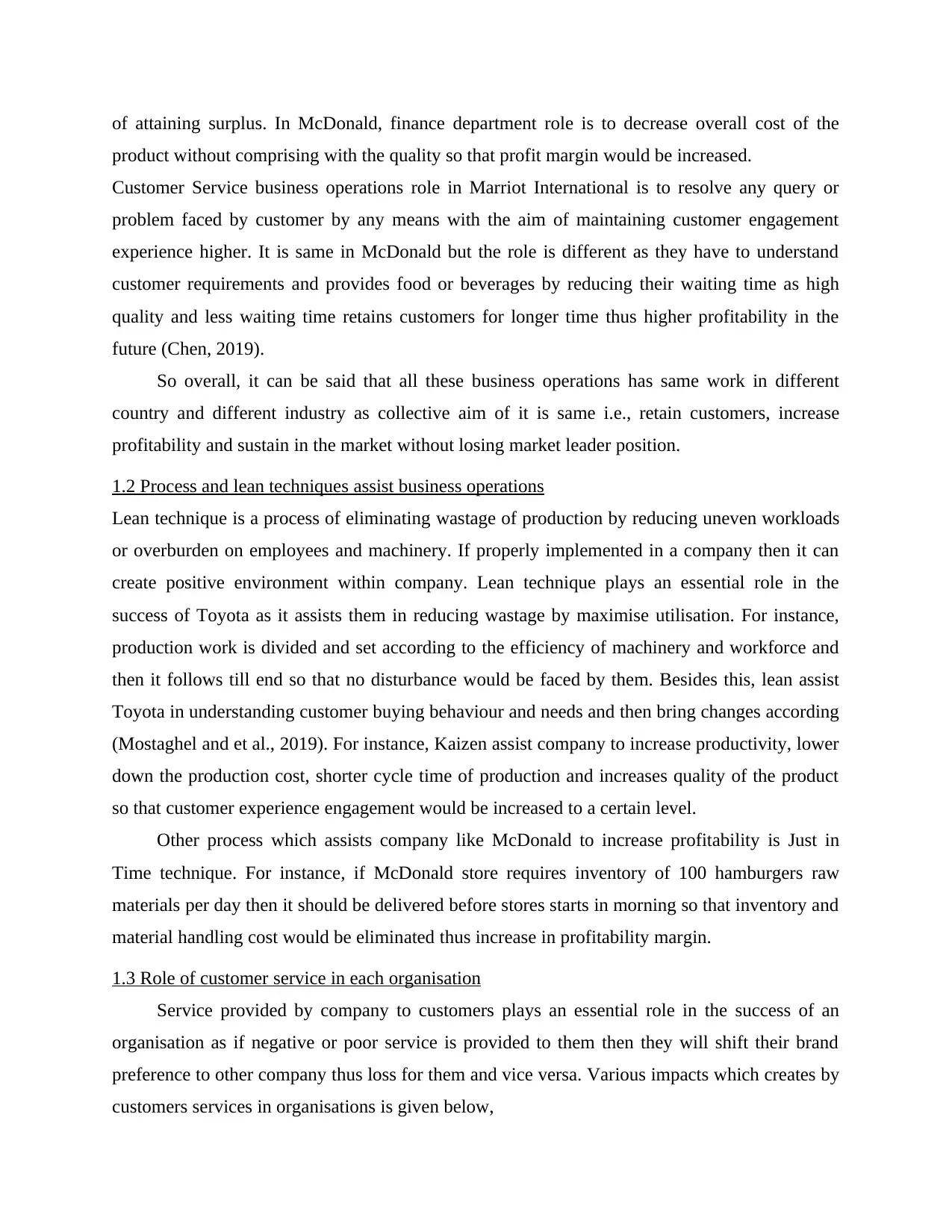
of attaining surplus. In McDonald, finance department role is to decrease overall cost of the
product without comprising with the quality so that profit margin would be increased.
Customer Service business operations role in Marriot International is to resolve any query or
problem faced by customer by any means with the aim of maintaining customer engagement
experience higher. It is same in McDonald but the role is different as they have to understand
customer requirements and provides food or beverages by reducing their waiting time as high
quality and less waiting time retains customers for longer time thus higher profitability in the
future (Chen, 2019).
So overall, it can be said that all these business operations has same work in different
country and different industry as collective aim of it is same i.e., retain customers, increase
profitability and sustain in the market without losing market leader position.
1.2 Process and lean techniques assist business operations
Lean technique is a process of eliminating wastage of production by reducing uneven workloads
or overburden on employees and machinery. If properly implemented in a company then it can
create positive environment within company. Lean technique plays an essential role in the
success of Toyota as it assists them in reducing wastage by maximise utilisation. For instance,
production work is divided and set according to the efficiency of machinery and workforce and
then it follows till end so that no disturbance would be faced by them. Besides this, lean assist
Toyota in understanding customer buying behaviour and needs and then bring changes according
(Mostaghel and et al., 2019). For instance, Kaizen assist company to increase productivity, lower
down the production cost, shorter cycle time of production and increases quality of the product
so that customer experience engagement would be increased to a certain level.
Other process which assists company like McDonald to increase profitability is Just in
Time technique. For instance, if McDonald store requires inventory of 100 hamburgers raw
materials per day then it should be delivered before stores starts in morning so that inventory and
material handling cost would be eliminated thus increase in profitability margin.
1.3 Role of customer service in each organisation
Service provided by company to customers plays an essential role in the success of an
organisation as if negative or poor service is provided to them then they will shift their brand
preference to other company thus loss for them and vice versa. Various impacts which creates by
customers services in organisations is given below,
product without comprising with the quality so that profit margin would be increased.
Customer Service business operations role in Marriot International is to resolve any query or
problem faced by customer by any means with the aim of maintaining customer engagement
experience higher. It is same in McDonald but the role is different as they have to understand
customer requirements and provides food or beverages by reducing their waiting time as high
quality and less waiting time retains customers for longer time thus higher profitability in the
future (Chen, 2019).
So overall, it can be said that all these business operations has same work in different
country and different industry as collective aim of it is same i.e., retain customers, increase
profitability and sustain in the market without losing market leader position.
1.2 Process and lean techniques assist business operations
Lean technique is a process of eliminating wastage of production by reducing uneven workloads
or overburden on employees and machinery. If properly implemented in a company then it can
create positive environment within company. Lean technique plays an essential role in the
success of Toyota as it assists them in reducing wastage by maximise utilisation. For instance,
production work is divided and set according to the efficiency of machinery and workforce and
then it follows till end so that no disturbance would be faced by them. Besides this, lean assist
Toyota in understanding customer buying behaviour and needs and then bring changes according
(Mostaghel and et al., 2019). For instance, Kaizen assist company to increase productivity, lower
down the production cost, shorter cycle time of production and increases quality of the product
so that customer experience engagement would be increased to a certain level.
Other process which assists company like McDonald to increase profitability is Just in
Time technique. For instance, if McDonald store requires inventory of 100 hamburgers raw
materials per day then it should be delivered before stores starts in morning so that inventory and
material handling cost would be eliminated thus increase in profitability margin.
1.3 Role of customer service in each organisation
Service provided by company to customers plays an essential role in the success of an
organisation as if negative or poor service is provided to them then they will shift their brand
preference to other company thus loss for them and vice versa. Various impacts which creates by
customers services in organisations is given below,
Paraphrase This Document
Need a fresh take? Get an instant paraphrase of this document with our AI Paraphraser
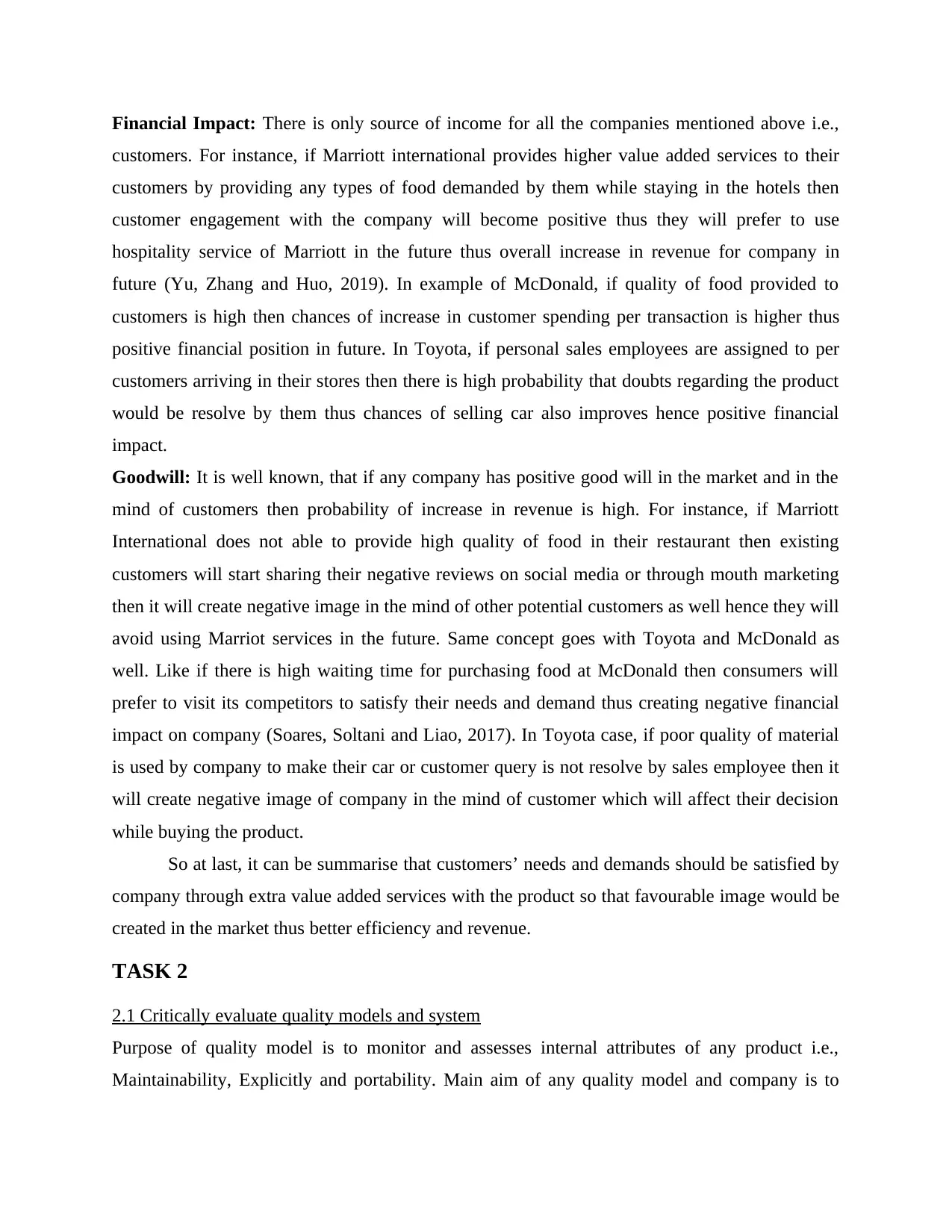
Financial Impact: There is only source of income for all the companies mentioned above i.e.,
customers. For instance, if Marriott international provides higher value added services to their
customers by providing any types of food demanded by them while staying in the hotels then
customer engagement with the company will become positive thus they will prefer to use
hospitality service of Marriott in the future thus overall increase in revenue for company in
future (Yu, Zhang and Huo, 2019). In example of McDonald, if quality of food provided to
customers is high then chances of increase in customer spending per transaction is higher thus
positive financial position in future. In Toyota, if personal sales employees are assigned to per
customers arriving in their stores then there is high probability that doubts regarding the product
would be resolve by them thus chances of selling car also improves hence positive financial
impact.
Goodwill: It is well known, that if any company has positive good will in the market and in the
mind of customers then probability of increase in revenue is high. For instance, if Marriott
International does not able to provide high quality of food in their restaurant then existing
customers will start sharing their negative reviews on social media or through mouth marketing
then it will create negative image in the mind of other potential customers as well hence they will
avoid using Marriot services in the future. Same concept goes with Toyota and McDonald as
well. Like if there is high waiting time for purchasing food at McDonald then consumers will
prefer to visit its competitors to satisfy their needs and demand thus creating negative financial
impact on company (Soares, Soltani and Liao, 2017). In Toyota case, if poor quality of material
is used by company to make their car or customer query is not resolve by sales employee then it
will create negative image of company in the mind of customer which will affect their decision
while buying the product.
So at last, it can be summarise that customers’ needs and demands should be satisfied by
company through extra value added services with the product so that favourable image would be
created in the market thus better efficiency and revenue.
TASK 2
2.1 Critically evaluate quality models and system
Purpose of quality model is to monitor and assesses internal attributes of any product i.e.,
Maintainability, Explicitly and portability. Main aim of any quality model and company is to
customers. For instance, if Marriott international provides higher value added services to their
customers by providing any types of food demanded by them while staying in the hotels then
customer engagement with the company will become positive thus they will prefer to use
hospitality service of Marriott in the future thus overall increase in revenue for company in
future (Yu, Zhang and Huo, 2019). In example of McDonald, if quality of food provided to
customers is high then chances of increase in customer spending per transaction is higher thus
positive financial position in future. In Toyota, if personal sales employees are assigned to per
customers arriving in their stores then there is high probability that doubts regarding the product
would be resolve by them thus chances of selling car also improves hence positive financial
impact.
Goodwill: It is well known, that if any company has positive good will in the market and in the
mind of customers then probability of increase in revenue is high. For instance, if Marriott
International does not able to provide high quality of food in their restaurant then existing
customers will start sharing their negative reviews on social media or through mouth marketing
then it will create negative image in the mind of other potential customers as well hence they will
avoid using Marriot services in the future. Same concept goes with Toyota and McDonald as
well. Like if there is high waiting time for purchasing food at McDonald then consumers will
prefer to visit its competitors to satisfy their needs and demand thus creating negative financial
impact on company (Soares, Soltani and Liao, 2017). In Toyota case, if poor quality of material
is used by company to make their car or customer query is not resolve by sales employee then it
will create negative image of company in the mind of customer which will affect their decision
while buying the product.
So at last, it can be summarise that customers’ needs and demands should be satisfied by
company through extra value added services with the product so that favourable image would be
created in the market thus better efficiency and revenue.
TASK 2
2.1 Critically evaluate quality models and system
Purpose of quality model is to monitor and assesses internal attributes of any product i.e.,
Maintainability, Explicitly and portability. Main aim of any quality model and company is to
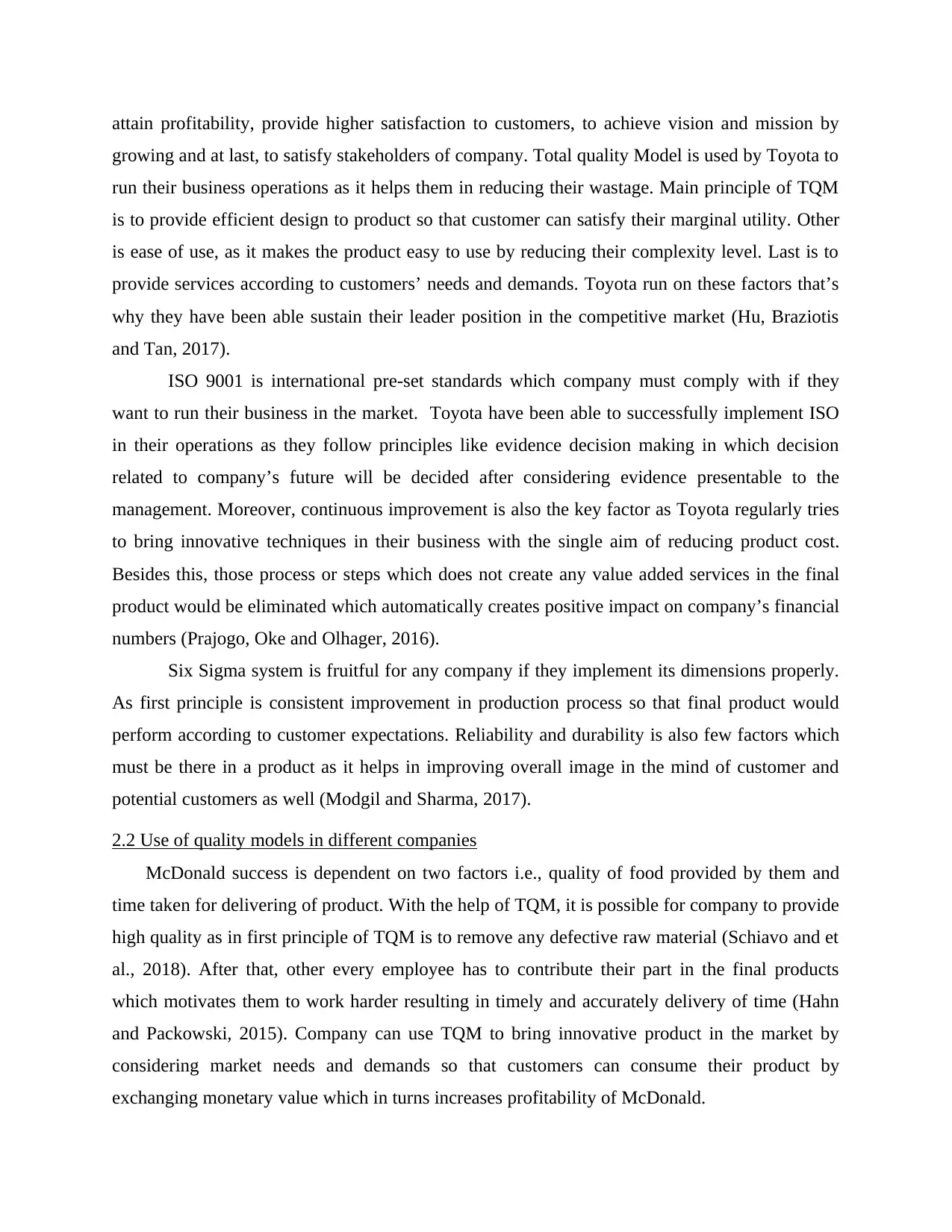
attain profitability, provide higher satisfaction to customers, to achieve vision and mission by
growing and at last, to satisfy stakeholders of company. Total quality Model is used by Toyota to
run their business operations as it helps them in reducing their wastage. Main principle of TQM
is to provide efficient design to product so that customer can satisfy their marginal utility. Other
is ease of use, as it makes the product easy to use by reducing their complexity level. Last is to
provide services according to customers’ needs and demands. Toyota run on these factors that’s
why they have been able sustain their leader position in the competitive market (Hu, Braziotis
and Tan, 2017).
ISO 9001 is international pre-set standards which company must comply with if they
want to run their business in the market. Toyota have been able to successfully implement ISO
in their operations as they follow principles like evidence decision making in which decision
related to company’s future will be decided after considering evidence presentable to the
management. Moreover, continuous improvement is also the key factor as Toyota regularly tries
to bring innovative techniques in their business with the single aim of reducing product cost.
Besides this, those process or steps which does not create any value added services in the final
product would be eliminated which automatically creates positive impact on company’s financial
numbers (Prajogo, Oke and Olhager, 2016).
Six Sigma system is fruitful for any company if they implement its dimensions properly.
As first principle is consistent improvement in production process so that final product would
perform according to customer expectations. Reliability and durability is also few factors which
must be there in a product as it helps in improving overall image in the mind of customer and
potential customers as well (Modgil and Sharma, 2017).
2.2 Use of quality models in different companies
McDonald success is dependent on two factors i.e., quality of food provided by them and
time taken for delivering of product. With the help of TQM, it is possible for company to provide
high quality as in first principle of TQM is to remove any defective raw material (Schiavo and et
al., 2018). After that, other every employee has to contribute their part in the final products
which motivates them to work harder resulting in timely and accurately delivery of time (Hahn
and Packowski, 2015). Company can use TQM to bring innovative product in the market by
considering market needs and demands so that customers can consume their product by
exchanging monetary value which in turns increases profitability of McDonald.
growing and at last, to satisfy stakeholders of company. Total quality Model is used by Toyota to
run their business operations as it helps them in reducing their wastage. Main principle of TQM
is to provide efficient design to product so that customer can satisfy their marginal utility. Other
is ease of use, as it makes the product easy to use by reducing their complexity level. Last is to
provide services according to customers’ needs and demands. Toyota run on these factors that’s
why they have been able sustain their leader position in the competitive market (Hu, Braziotis
and Tan, 2017).
ISO 9001 is international pre-set standards which company must comply with if they
want to run their business in the market. Toyota have been able to successfully implement ISO
in their operations as they follow principles like evidence decision making in which decision
related to company’s future will be decided after considering evidence presentable to the
management. Moreover, continuous improvement is also the key factor as Toyota regularly tries
to bring innovative techniques in their business with the single aim of reducing product cost.
Besides this, those process or steps which does not create any value added services in the final
product would be eliminated which automatically creates positive impact on company’s financial
numbers (Prajogo, Oke and Olhager, 2016).
Six Sigma system is fruitful for any company if they implement its dimensions properly.
As first principle is consistent improvement in production process so that final product would
perform according to customer expectations. Reliability and durability is also few factors which
must be there in a product as it helps in improving overall image in the mind of customer and
potential customers as well (Modgil and Sharma, 2017).
2.2 Use of quality models in different companies
McDonald success is dependent on two factors i.e., quality of food provided by them and
time taken for delivering of product. With the help of TQM, it is possible for company to provide
high quality as in first principle of TQM is to remove any defective raw material (Schiavo and et
al., 2018). After that, other every employee has to contribute their part in the final products
which motivates them to work harder resulting in timely and accurately delivery of time (Hahn
and Packowski, 2015). Company can use TQM to bring innovative product in the market by
considering market needs and demands so that customers can consume their product by
exchanging monetary value which in turns increases profitability of McDonald.
⊘ This is a preview!⊘
Do you want full access?
Subscribe today to unlock all pages.

Trusted by 1+ million students worldwide
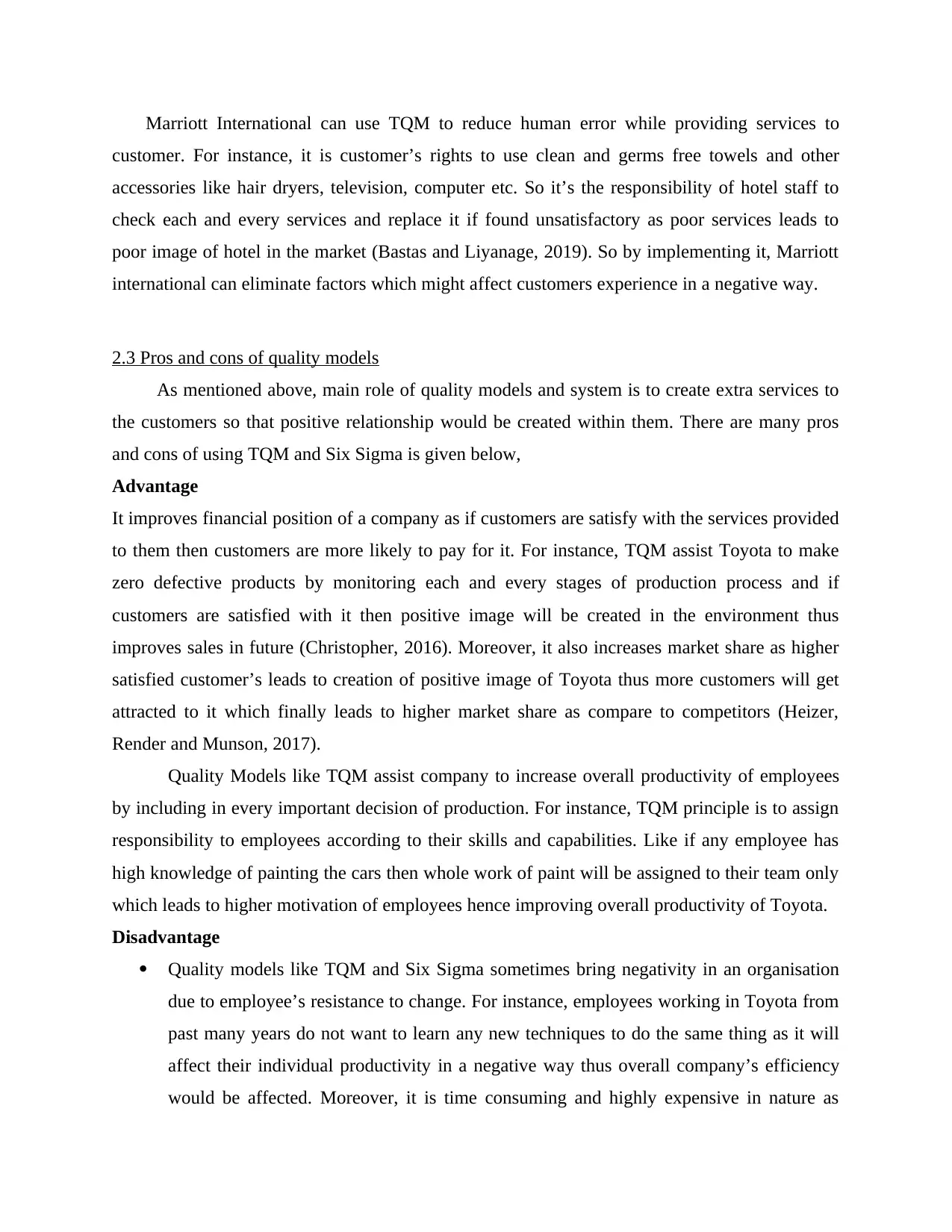
Marriott International can use TQM to reduce human error while providing services to
customer. For instance, it is customer’s rights to use clean and germs free towels and other
accessories like hair dryers, television, computer etc. So it’s the responsibility of hotel staff to
check each and every services and replace it if found unsatisfactory as poor services leads to
poor image of hotel in the market (Bastas and Liyanage, 2019). So by implementing it, Marriott
international can eliminate factors which might affect customers experience in a negative way.
2.3 Pros and cons of quality models
As mentioned above, main role of quality models and system is to create extra services to
the customers so that positive relationship would be created within them. There are many pros
and cons of using TQM and Six Sigma is given below,
Advantage
It improves financial position of a company as if customers are satisfy with the services provided
to them then customers are more likely to pay for it. For instance, TQM assist Toyota to make
zero defective products by monitoring each and every stages of production process and if
customers are satisfied with it then positive image will be created in the environment thus
improves sales in future (Christopher, 2016). Moreover, it also increases market share as higher
satisfied customer’s leads to creation of positive image of Toyota thus more customers will get
attracted to it which finally leads to higher market share as compare to competitors (Heizer,
Render and Munson, 2017).
Quality Models like TQM assist company to increase overall productivity of employees
by including in every important decision of production. For instance, TQM principle is to assign
responsibility to employees according to their skills and capabilities. Like if any employee has
high knowledge of painting the cars then whole work of paint will be assigned to their team only
which leads to higher motivation of employees hence improving overall productivity of Toyota.
Disadvantage
Quality models like TQM and Six Sigma sometimes bring negativity in an organisation
due to employee’s resistance to change. For instance, employees working in Toyota from
past many years do not want to learn any new techniques to do the same thing as it will
affect their individual productivity in a negative way thus overall company’s efficiency
would be affected. Moreover, it is time consuming and highly expensive in nature as
customer. For instance, it is customer’s rights to use clean and germs free towels and other
accessories like hair dryers, television, computer etc. So it’s the responsibility of hotel staff to
check each and every services and replace it if found unsatisfactory as poor services leads to
poor image of hotel in the market (Bastas and Liyanage, 2019). So by implementing it, Marriott
international can eliminate factors which might affect customers experience in a negative way.
2.3 Pros and cons of quality models
As mentioned above, main role of quality models and system is to create extra services to
the customers so that positive relationship would be created within them. There are many pros
and cons of using TQM and Six Sigma is given below,
Advantage
It improves financial position of a company as if customers are satisfy with the services provided
to them then customers are more likely to pay for it. For instance, TQM assist Toyota to make
zero defective products by monitoring each and every stages of production process and if
customers are satisfied with it then positive image will be created in the environment thus
improves sales in future (Christopher, 2016). Moreover, it also increases market share as higher
satisfied customer’s leads to creation of positive image of Toyota thus more customers will get
attracted to it which finally leads to higher market share as compare to competitors (Heizer,
Render and Munson, 2017).
Quality Models like TQM assist company to increase overall productivity of employees
by including in every important decision of production. For instance, TQM principle is to assign
responsibility to employees according to their skills and capabilities. Like if any employee has
high knowledge of painting the cars then whole work of paint will be assigned to their team only
which leads to higher motivation of employees hence improving overall productivity of Toyota.
Disadvantage
Quality models like TQM and Six Sigma sometimes bring negativity in an organisation
due to employee’s resistance to change. For instance, employees working in Toyota from
past many years do not want to learn any new techniques to do the same thing as it will
affect their individual productivity in a negative way thus overall company’s efficiency
would be affected. Moreover, it is time consuming and highly expensive in nature as
Paraphrase This Document
Need a fresh take? Get an instant paraphrase of this document with our AI Paraphraser
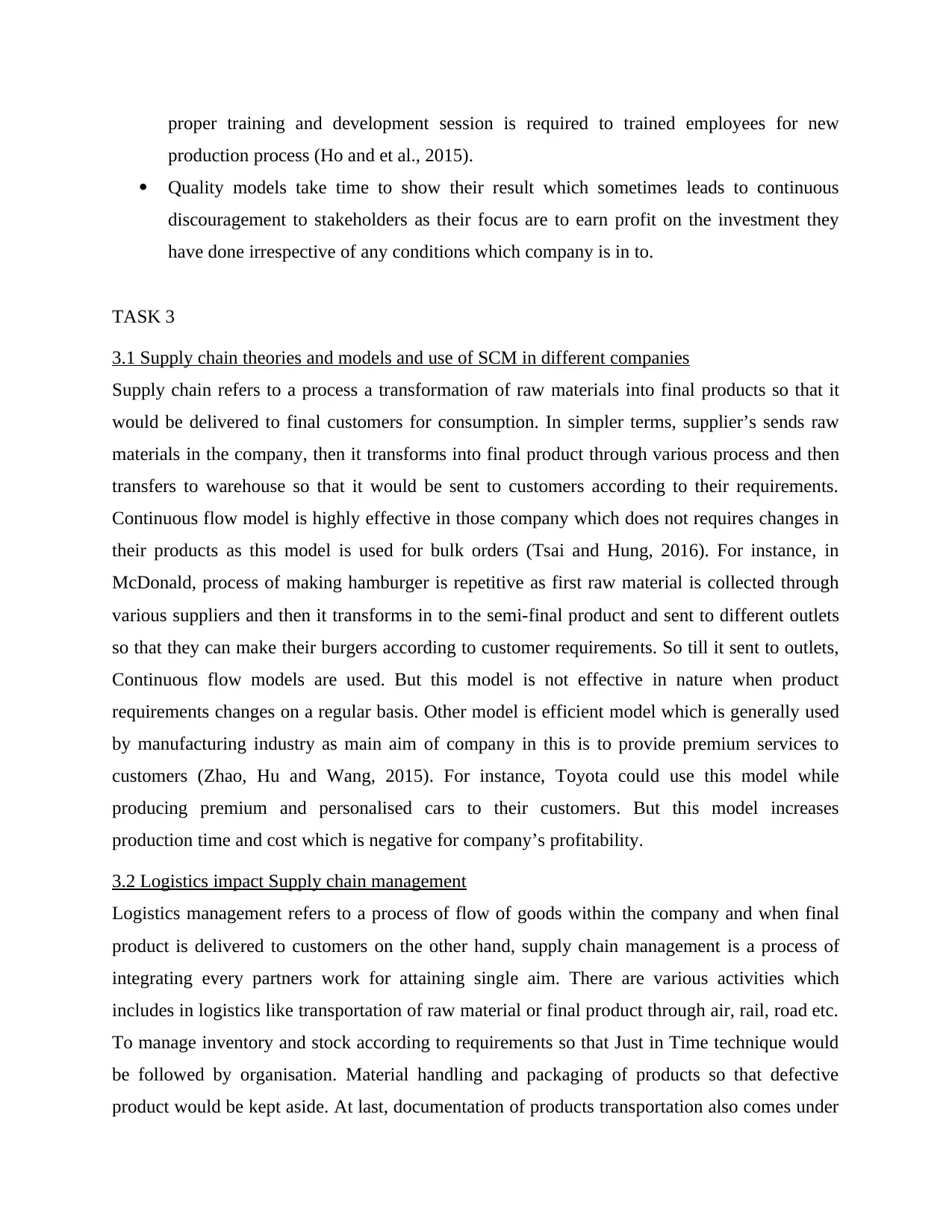
proper training and development session is required to trained employees for new
production process (Ho and et al., 2015).
Quality models take time to show their result which sometimes leads to continuous
discouragement to stakeholders as their focus are to earn profit on the investment they
have done irrespective of any conditions which company is in to.
TASK 3
3.1 Supply chain theories and models and use of SCM in different companies
Supply chain refers to a process a transformation of raw materials into final products so that it
would be delivered to final customers for consumption. In simpler terms, supplier’s sends raw
materials in the company, then it transforms into final product through various process and then
transfers to warehouse so that it would be sent to customers according to their requirements.
Continuous flow model is highly effective in those company which does not requires changes in
their products as this model is used for bulk orders (Tsai and Hung, 2016). For instance, in
McDonald, process of making hamburger is repetitive as first raw material is collected through
various suppliers and then it transforms in to the semi-final product and sent to different outlets
so that they can make their burgers according to customer requirements. So till it sent to outlets,
Continuous flow models are used. But this model is not effective in nature when product
requirements changes on a regular basis. Other model is efficient model which is generally used
by manufacturing industry as main aim of company in this is to provide premium services to
customers (Zhao, Hu and Wang, 2015). For instance, Toyota could use this model while
producing premium and personalised cars to their customers. But this model increases
production time and cost which is negative for company’s profitability.
3.2 Logistics impact Supply chain management
Logistics management refers to a process of flow of goods within the company and when final
product is delivered to customers on the other hand, supply chain management is a process of
integrating every partners work for attaining single aim. There are various activities which
includes in logistics like transportation of raw material or final product through air, rail, road etc.
To manage inventory and stock according to requirements so that Just in Time technique would
be followed by organisation. Material handling and packaging of products so that defective
product would be kept aside. At last, documentation of products transportation also comes under
production process (Ho and et al., 2015).
Quality models take time to show their result which sometimes leads to continuous
discouragement to stakeholders as their focus are to earn profit on the investment they
have done irrespective of any conditions which company is in to.
TASK 3
3.1 Supply chain theories and models and use of SCM in different companies
Supply chain refers to a process a transformation of raw materials into final products so that it
would be delivered to final customers for consumption. In simpler terms, supplier’s sends raw
materials in the company, then it transforms into final product through various process and then
transfers to warehouse so that it would be sent to customers according to their requirements.
Continuous flow model is highly effective in those company which does not requires changes in
their products as this model is used for bulk orders (Tsai and Hung, 2016). For instance, in
McDonald, process of making hamburger is repetitive as first raw material is collected through
various suppliers and then it transforms in to the semi-final product and sent to different outlets
so that they can make their burgers according to customer requirements. So till it sent to outlets,
Continuous flow models are used. But this model is not effective in nature when product
requirements changes on a regular basis. Other model is efficient model which is generally used
by manufacturing industry as main aim of company in this is to provide premium services to
customers (Zhao, Hu and Wang, 2015). For instance, Toyota could use this model while
producing premium and personalised cars to their customers. But this model increases
production time and cost which is negative for company’s profitability.
3.2 Logistics impact Supply chain management
Logistics management refers to a process of flow of goods within the company and when final
product is delivered to customers on the other hand, supply chain management is a process of
integrating every partners work for attaining single aim. There are various activities which
includes in logistics like transportation of raw material or final product through air, rail, road etc.
To manage inventory and stock according to requirements so that Just in Time technique would
be followed by organisation. Material handling and packaging of products so that defective
product would be kept aside. At last, documentation of products transportation also comes under
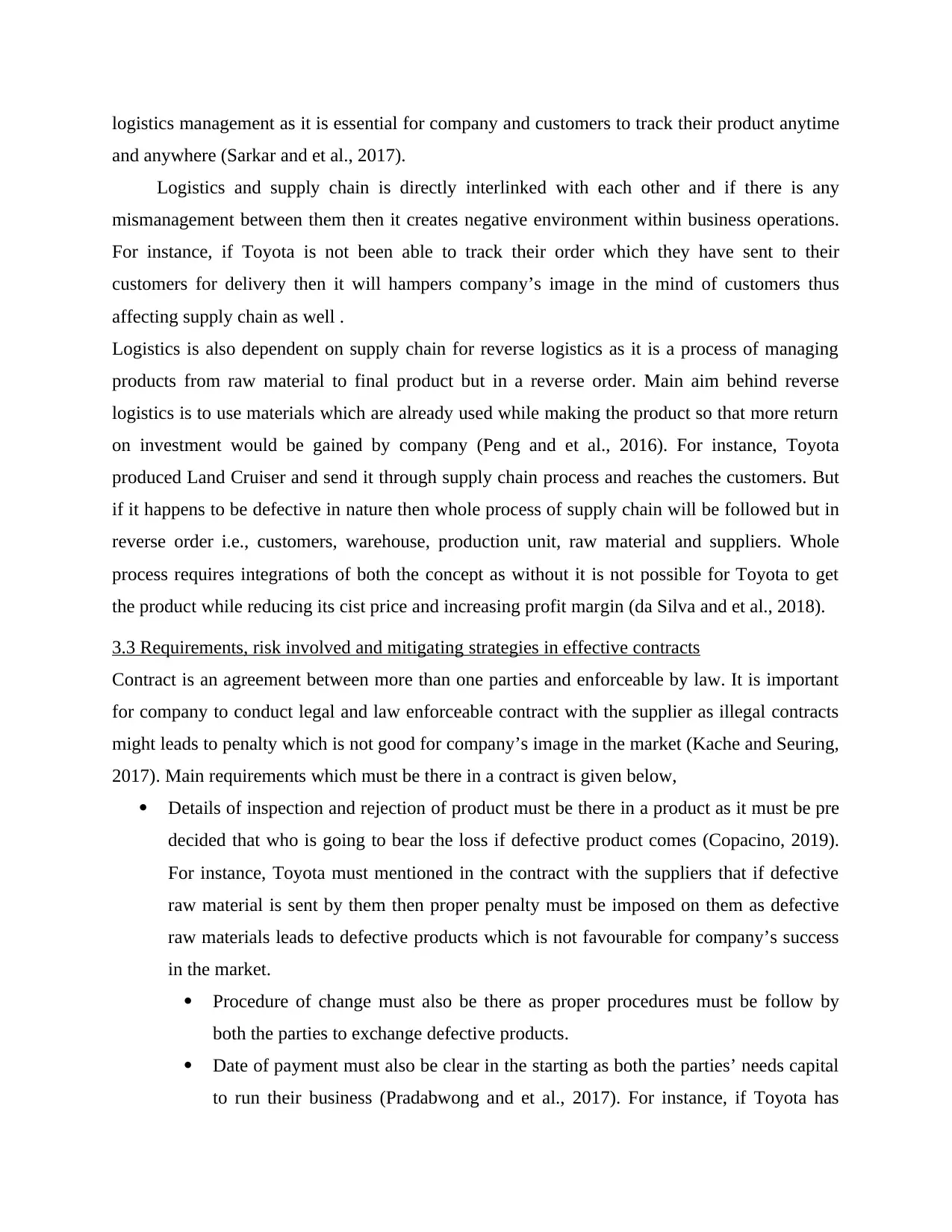
logistics management as it is essential for company and customers to track their product anytime
and anywhere (Sarkar and et al., 2017).
Logistics and supply chain is directly interlinked with each other and if there is any
mismanagement between them then it creates negative environment within business operations.
For instance, if Toyota is not been able to track their order which they have sent to their
customers for delivery then it will hampers company’s image in the mind of customers thus
affecting supply chain as well .
Logistics is also dependent on supply chain for reverse logistics as it is a process of managing
products from raw material to final product but in a reverse order. Main aim behind reverse
logistics is to use materials which are already used while making the product so that more return
on investment would be gained by company (Peng and et al., 2016). For instance, Toyota
produced Land Cruiser and send it through supply chain process and reaches the customers. But
if it happens to be defective in nature then whole process of supply chain will be followed but in
reverse order i.e., customers, warehouse, production unit, raw material and suppliers. Whole
process requires integrations of both the concept as without it is not possible for Toyota to get
the product while reducing its cist price and increasing profit margin (da Silva and et al., 2018).
3.3 Requirements, risk involved and mitigating strategies in effective contracts
Contract is an agreement between more than one parties and enforceable by law. It is important
for company to conduct legal and law enforceable contract with the supplier as illegal contracts
might leads to penalty which is not good for company’s image in the market (Kache and Seuring,
2017). Main requirements which must be there in a contract is given below,
Details of inspection and rejection of product must be there in a product as it must be pre
decided that who is going to bear the loss if defective product comes (Copacino, 2019).
For instance, Toyota must mentioned in the contract with the suppliers that if defective
raw material is sent by them then proper penalty must be imposed on them as defective
raw materials leads to defective products which is not favourable for company’s success
in the market.
Procedure of change must also be there as proper procedures must be follow by
both the parties to exchange defective products.
Date of payment must also be clear in the starting as both the parties’ needs capital
to run their business (Pradabwong and et al., 2017). For instance, if Toyota has
and anywhere (Sarkar and et al., 2017).
Logistics and supply chain is directly interlinked with each other and if there is any
mismanagement between them then it creates negative environment within business operations.
For instance, if Toyota is not been able to track their order which they have sent to their
customers for delivery then it will hampers company’s image in the mind of customers thus
affecting supply chain as well .
Logistics is also dependent on supply chain for reverse logistics as it is a process of managing
products from raw material to final product but in a reverse order. Main aim behind reverse
logistics is to use materials which are already used while making the product so that more return
on investment would be gained by company (Peng and et al., 2016). For instance, Toyota
produced Land Cruiser and send it through supply chain process and reaches the customers. But
if it happens to be defective in nature then whole process of supply chain will be followed but in
reverse order i.e., customers, warehouse, production unit, raw material and suppliers. Whole
process requires integrations of both the concept as without it is not possible for Toyota to get
the product while reducing its cist price and increasing profit margin (da Silva and et al., 2018).
3.3 Requirements, risk involved and mitigating strategies in effective contracts
Contract is an agreement between more than one parties and enforceable by law. It is important
for company to conduct legal and law enforceable contract with the supplier as illegal contracts
might leads to penalty which is not good for company’s image in the market (Kache and Seuring,
2017). Main requirements which must be there in a contract is given below,
Details of inspection and rejection of product must be there in a product as it must be pre
decided that who is going to bear the loss if defective product comes (Copacino, 2019).
For instance, Toyota must mentioned in the contract with the suppliers that if defective
raw material is sent by them then proper penalty must be imposed on them as defective
raw materials leads to defective products which is not favourable for company’s success
in the market.
Procedure of change must also be there as proper procedures must be follow by
both the parties to exchange defective products.
Date of payment must also be clear in the starting as both the parties’ needs capital
to run their business (Pradabwong and et al., 2017). For instance, if Toyota has
⊘ This is a preview!⊘
Do you want full access?
Subscribe today to unlock all pages.

Trusted by 1+ million students worldwide
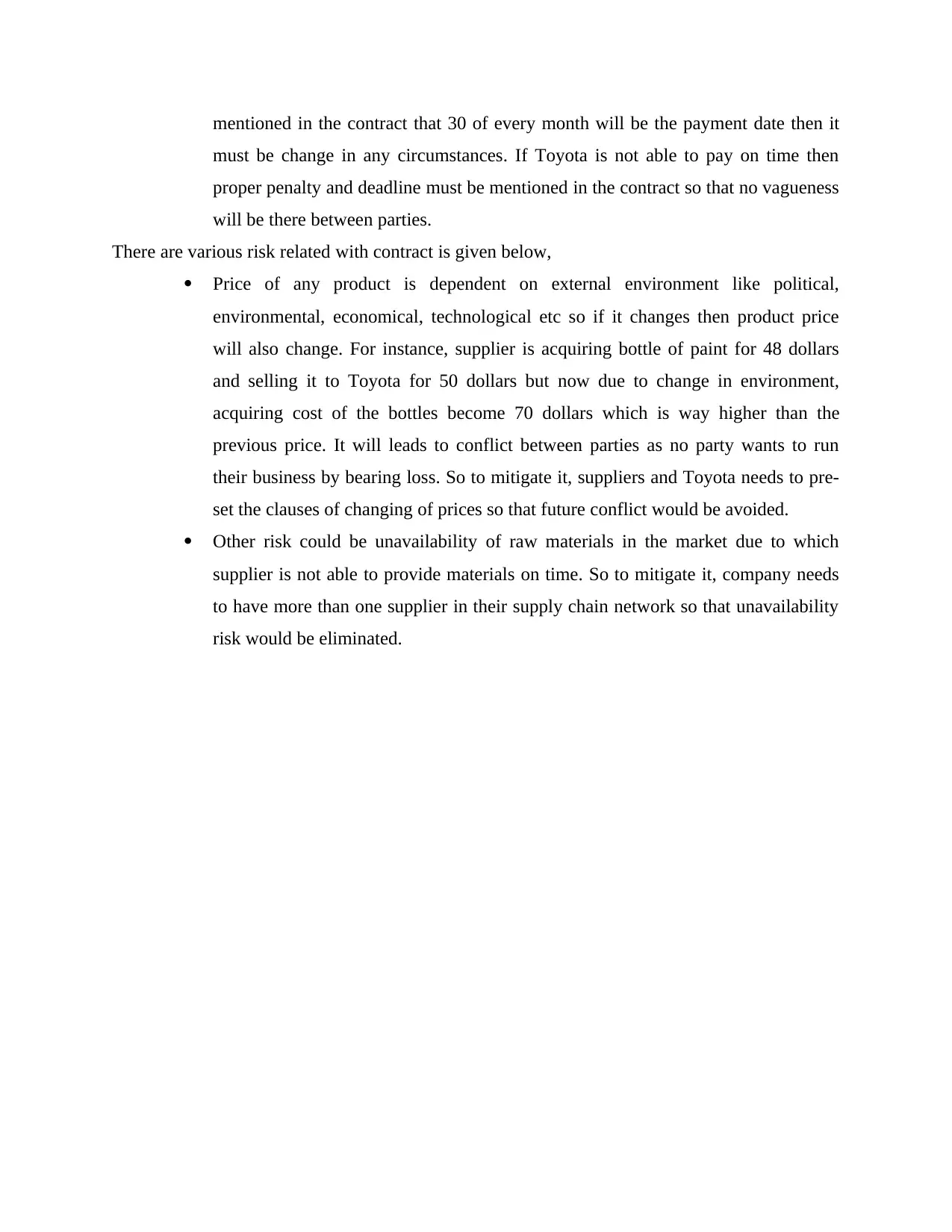
mentioned in the contract that 30 of every month will be the payment date then it
must be change in any circumstances. If Toyota is not able to pay on time then
proper penalty and deadline must be mentioned in the contract so that no vagueness
will be there between parties.
There are various risk related with contract is given below,
Price of any product is dependent on external environment like political,
environmental, economical, technological etc so if it changes then product price
will also change. For instance, supplier is acquiring bottle of paint for 48 dollars
and selling it to Toyota for 50 dollars but now due to change in environment,
acquiring cost of the bottles become 70 dollars which is way higher than the
previous price. It will leads to conflict between parties as no party wants to run
their business by bearing loss. So to mitigate it, suppliers and Toyota needs to pre-
set the clauses of changing of prices so that future conflict would be avoided.
Other risk could be unavailability of raw materials in the market due to which
supplier is not able to provide materials on time. So to mitigate it, company needs
to have more than one supplier in their supply chain network so that unavailability
risk would be eliminated.
must be change in any circumstances. If Toyota is not able to pay on time then
proper penalty and deadline must be mentioned in the contract so that no vagueness
will be there between parties.
There are various risk related with contract is given below,
Price of any product is dependent on external environment like political,
environmental, economical, technological etc so if it changes then product price
will also change. For instance, supplier is acquiring bottle of paint for 48 dollars
and selling it to Toyota for 50 dollars but now due to change in environment,
acquiring cost of the bottles become 70 dollars which is way higher than the
previous price. It will leads to conflict between parties as no party wants to run
their business by bearing loss. So to mitigate it, suppliers and Toyota needs to pre-
set the clauses of changing of prices so that future conflict would be avoided.
Other risk could be unavailability of raw materials in the market due to which
supplier is not able to provide materials on time. So to mitigate it, company needs
to have more than one supplier in their supply chain network so that unavailability
risk would be eliminated.
Paraphrase This Document
Need a fresh take? Get an instant paraphrase of this document with our AI Paraphraser
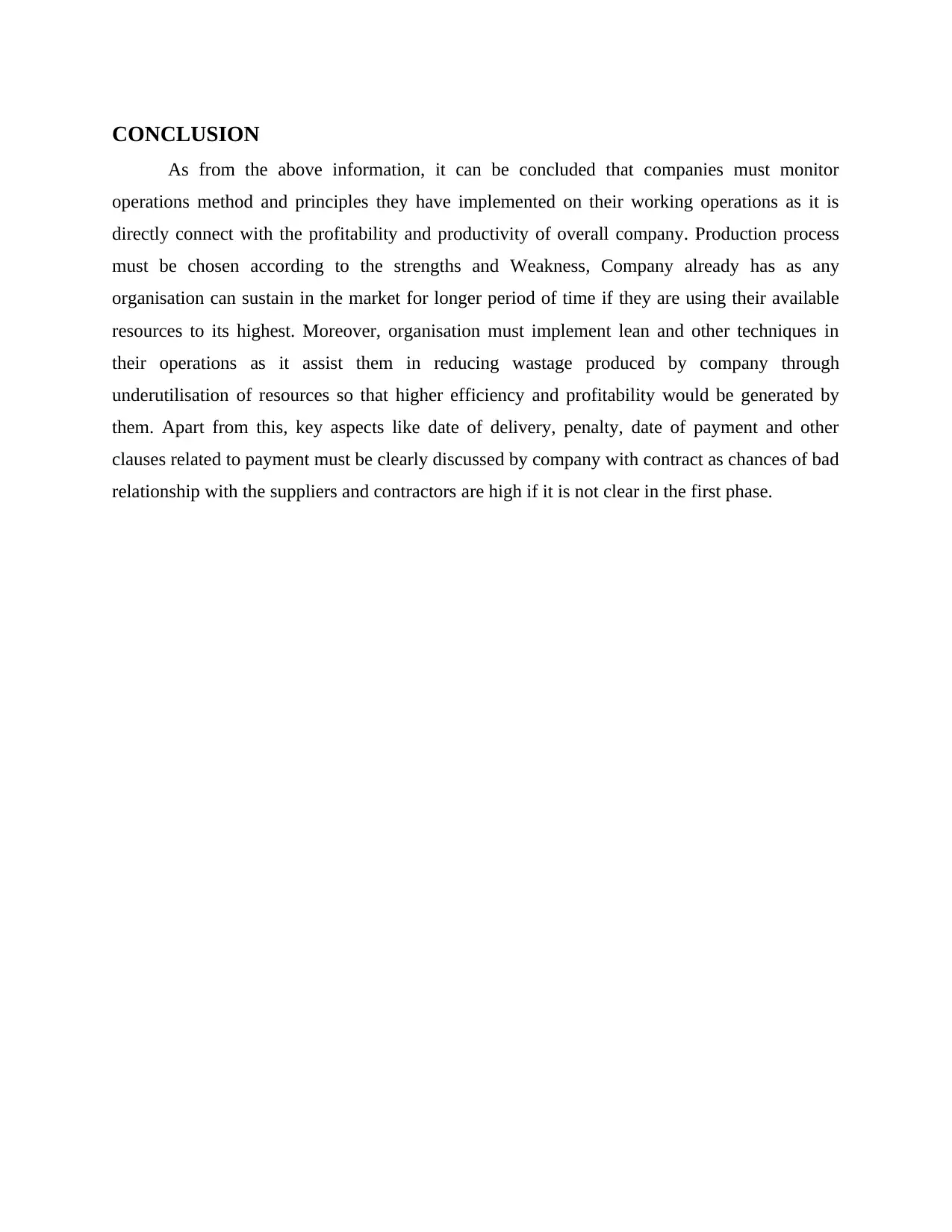
CONCLUSION
As from the above information, it can be concluded that companies must monitor
operations method and principles they have implemented on their working operations as it is
directly connect with the profitability and productivity of overall company. Production process
must be chosen according to the strengths and Weakness, Company already has as any
organisation can sustain in the market for longer period of time if they are using their available
resources to its highest. Moreover, organisation must implement lean and other techniques in
their operations as it assist them in reducing wastage produced by company through
underutilisation of resources so that higher efficiency and profitability would be generated by
them. Apart from this, key aspects like date of delivery, penalty, date of payment and other
clauses related to payment must be clearly discussed by company with contract as chances of bad
relationship with the suppliers and contractors are high if it is not clear in the first phase.
As from the above information, it can be concluded that companies must monitor
operations method and principles they have implemented on their working operations as it is
directly connect with the profitability and productivity of overall company. Production process
must be chosen according to the strengths and Weakness, Company already has as any
organisation can sustain in the market for longer period of time if they are using their available
resources to its highest. Moreover, organisation must implement lean and other techniques in
their operations as it assist them in reducing wastage produced by company through
underutilisation of resources so that higher efficiency and profitability would be generated by
them. Apart from this, key aspects like date of delivery, penalty, date of payment and other
clauses related to payment must be clearly discussed by company with contract as chances of bad
relationship with the suppliers and contractors are high if it is not clear in the first phase.
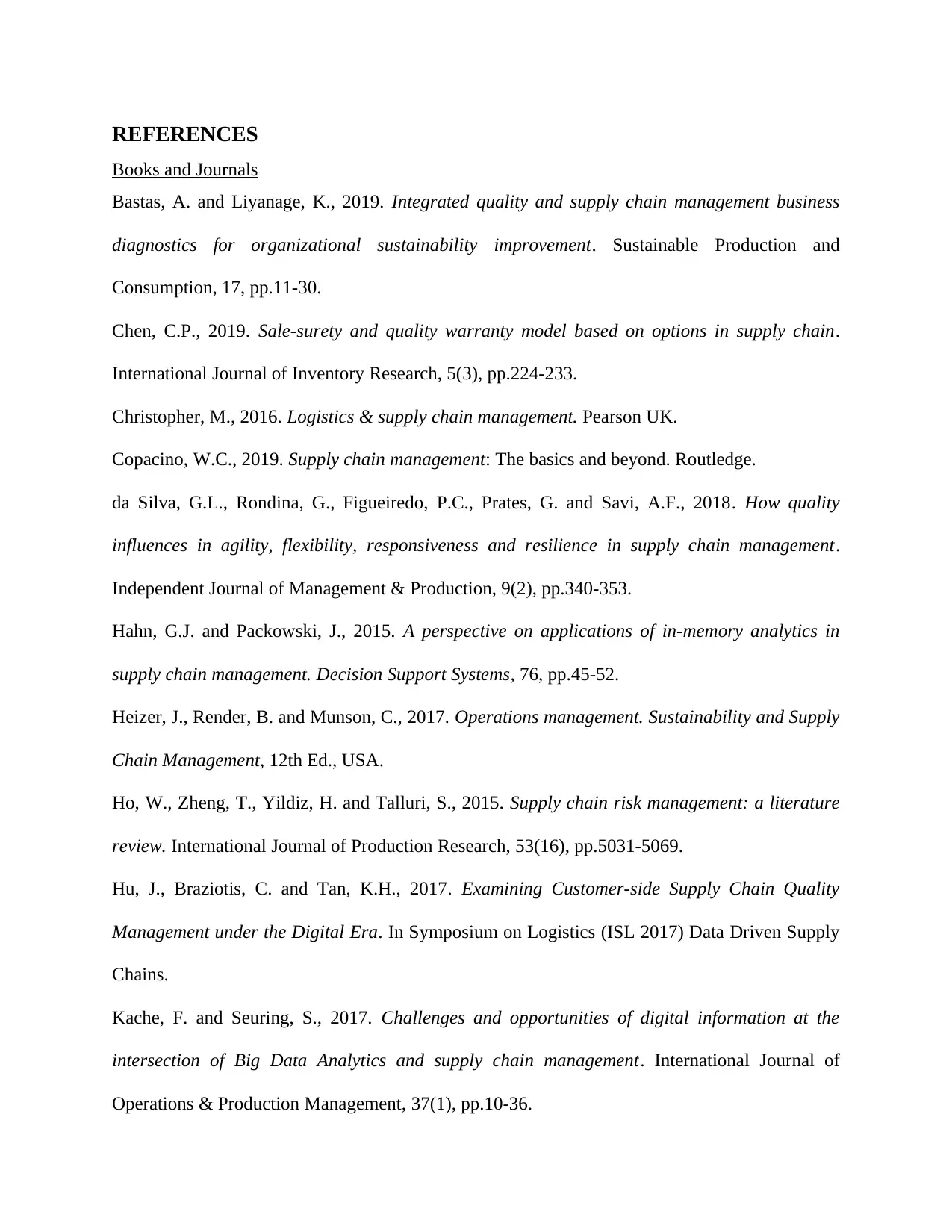
REFERENCES
Books and Journals
Bastas, A. and Liyanage, K., 2019. Integrated quality and supply chain management business
diagnostics for organizational sustainability improvement. Sustainable Production and
Consumption, 17, pp.11-30.
Chen, C.P., 2019. Sale-surety and quality warranty model based on options in supply chain.
International Journal of Inventory Research, 5(3), pp.224-233.
Christopher, M., 2016. Logistics & supply chain management. Pearson UK.
Copacino, W.C., 2019. Supply chain management: The basics and beyond. Routledge.
da Silva, G.L., Rondina, G., Figueiredo, P.C., Prates, G. and Savi, A.F., 2018. How quality
influences in agility, flexibility, responsiveness and resilience in supply chain management.
Independent Journal of Management & Production, 9(2), pp.340-353.
Hahn, G.J. and Packowski, J., 2015. A perspective on applications of in-memory analytics in
supply chain management. Decision Support Systems, 76, pp.45-52.
Heizer, J., Render, B. and Munson, C., 2017. Operations management. Sustainability and Supply
Chain Management, 12th Ed., USA.
Ho, W., Zheng, T., Yildiz, H. and Talluri, S., 2015. Supply chain risk management: a literature
review. International Journal of Production Research, 53(16), pp.5031-5069.
Hu, J., Braziotis, C. and Tan, K.H., 2017. Examining Customer-side Supply Chain Quality
Management under the Digital Era. In Symposium on Logistics (ISL 2017) Data Driven Supply
Chains.
Kache, F. and Seuring, S., 2017. Challenges and opportunities of digital information at the
intersection of Big Data Analytics and supply chain management. International Journal of
Operations & Production Management, 37(1), pp.10-36.
Books and Journals
Bastas, A. and Liyanage, K., 2019. Integrated quality and supply chain management business
diagnostics for organizational sustainability improvement. Sustainable Production and
Consumption, 17, pp.11-30.
Chen, C.P., 2019. Sale-surety and quality warranty model based on options in supply chain.
International Journal of Inventory Research, 5(3), pp.224-233.
Christopher, M., 2016. Logistics & supply chain management. Pearson UK.
Copacino, W.C., 2019. Supply chain management: The basics and beyond. Routledge.
da Silva, G.L., Rondina, G., Figueiredo, P.C., Prates, G. and Savi, A.F., 2018. How quality
influences in agility, flexibility, responsiveness and resilience in supply chain management.
Independent Journal of Management & Production, 9(2), pp.340-353.
Hahn, G.J. and Packowski, J., 2015. A perspective on applications of in-memory analytics in
supply chain management. Decision Support Systems, 76, pp.45-52.
Heizer, J., Render, B. and Munson, C., 2017. Operations management. Sustainability and Supply
Chain Management, 12th Ed., USA.
Ho, W., Zheng, T., Yildiz, H. and Talluri, S., 2015. Supply chain risk management: a literature
review. International Journal of Production Research, 53(16), pp.5031-5069.
Hu, J., Braziotis, C. and Tan, K.H., 2017. Examining Customer-side Supply Chain Quality
Management under the Digital Era. In Symposium on Logistics (ISL 2017) Data Driven Supply
Chains.
Kache, F. and Seuring, S., 2017. Challenges and opportunities of digital information at the
intersection of Big Data Analytics and supply chain management. International Journal of
Operations & Production Management, 37(1), pp.10-36.
⊘ This is a preview!⊘
Do you want full access?
Subscribe today to unlock all pages.

Trusted by 1+ million students worldwide
1 out of 15
Related Documents
Your All-in-One AI-Powered Toolkit for Academic Success.
+13062052269
info@desklib.com
Available 24*7 on WhatsApp / Email
![[object Object]](/_next/static/media/star-bottom.7253800d.svg)
Unlock your academic potential
Copyright © 2020–2025 A2Z Services. All Rights Reserved. Developed and managed by ZUCOL.





